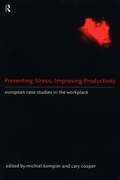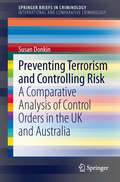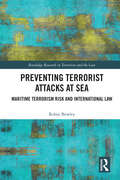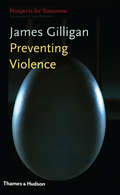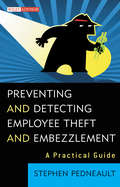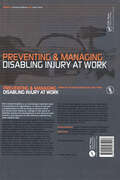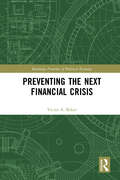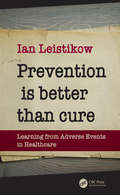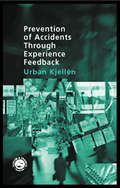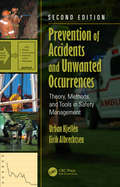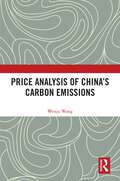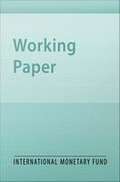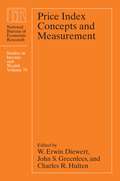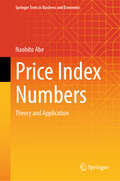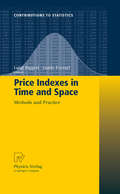- Table View
- List View
Preventing Occupational Exposures to Infectious Disease in Health Care: A Practical Guide
by Amber Hogan MitchellThis book is a practical guide for preventing occupational exposures to bloodborne and infectious disease in health care. It is a timely and essential resource given that people working in healthcare settings sustain a higher incidence of occupational illness than any other industry sector, and at the time of publication of this book we are in the midst of a global pandemic of COVID-19. While the guide is focused on health care primarily, it would be useful for preventing exposures to essential workers in many other industries as well.The guide offers easy-to-follow instruction, all in one place, for creating, implementing, and evaluating occupational health and safety programs. Readers have practical information that they can use now to either build a new program or expand an existing one that protects workers from occupationally associated illness and infection. With a focus on the public health significance of building better, safer programs in health care, the book provides not just the evidence-based or data-driven reasoning behind building successful programs, but also includes sample programs, plans, checklists, campaigns, and record-keeping and surveillance tools. Topics explored among the chapters include: • Occupational Safety and Health Administration (OSHA) Regulatory Compliance • Other Regulatory Requirements, National Standards, and Accreditation • Performing a Hazard Assessment and Building an Exposure Control Plan • Engineering Controls and Safer Medical Devices • Personal Protective Equipment Placement and Use • Facing a Modern PandemicPreventing Occupational Exposures to Infectious Disease in Health Care is a comprehensive resource for both seasoned and novice professionals with primary, secondary, or ancillary responsibility for occupational or employee health and safety, infection prevention, risk management, or environmental health and safety in a variety of healthcare or patient care settings. It also would appeal to those working in public health, nursing, medical, or clinical technical trades with an interest in infection prevention and control and/or occupational health and infectious disease.
Preventing Regulatory Capture
by David A. Moss Daniel CarpenterWhen regulations (or lack thereof) seem to detract from the common good, critics often point to regulatory capture as a culprit. In some academic and policy circles it seems to have assumed the status of an immutable law. Yet for all the ink spilled describing and decrying capture, the concept remains difficult to nail down in practice. Is capture truly as powerful and unpreventable as the informed consensus seems to suggest? This edited volume brings together seventeen scholars from across the social sciences to address this question. Their work shows that capture is often misdiagnosed and may in fact be preventable and manageable. Focusing on the goal of prevention, the volume advances a more rigorous and empirical standard for diagnosing and measuring capture, paving the way for new lines of academic inquiry and more precise and nuanced reform.
Preventing Stress, Improving Productivity: European Case-Studies in the Workplace
by Cary Cooper Michiel KompierIn a representative study made of European workers, twenty-eight per cent of employees reported that stress affects their health and their performance at work. Occupational stress is a serious problem for the performance of individuals, organisations and as a consequence, for national economies. Preventing Stress, Improving Productivity investigates the ways in which companies can combat stress by changing the working environment rather than only treating individual employees with stress symptoms.Costs and benefits of stress prevention are discussed, with an emphasis on appraoches that involve both the work situation and the individual worker. The heart of the book consists of eleven European country chapters, each overviewing the current status with respect to occupational stress and its prevention in that country and then presenting one detailed case study an example of good preventive practice. Preventing Stress, Improving Productivity identifies five factors that are critical for a stress reduction programme to work, both in terms of employee health and well-being and from a financial point of view. Successful strategies combine participation from workers and support from top management. Useful as a reference for psychologists, human resource managers, occupational physicians, ergonomists and consultants, this book will also be an invaluable aid to managers in the day-to-day running of organisations.
Preventing Terrorism and Controlling Risk
by Susan DonkinThis Brief takes a provocative look at existing socio-legal literature with a comparative study of terrorism control orders, focusing on how the concept of pre-emption fits within a traditional criminological framework. This timely work examines how such measures might be conceived and interpreted within a situational crime prevention approach. Over the past decade, socio-legal scholars have identified a rise in pre-emptive control mechanisms to respond to terrorism and other threats in the post-9/11 world. Many have argued that this pre-emptive rationale has been used to justify the introduction of measures that transcend established legal and risk frameworks, to deal with individuals or groups thought to pose a threat to the state or its citizens. Preventing Terrorism and Controlling Risk: A Comparative Analysis of Control Orders in the UK and Australia will be of interest to researchers in Criminology and Criminal Justice, particularly with a focus on terrorism, risk assessment, and human rights.
Preventing Terrorist Attacks at Sea: Maritime Terrorism Risk and International Law (Routledge Research in Terrorism and the Law)
by Robin BowleyOver recent decades, it has been widely recognised that terrorist attacks at sea could result in major casualties and cause significant disruptions to the free flow of international shipping. After discussing the overlaps and distinctions between piracy and maritime terrorism, this book considers how the International Ship and Port Facility Security Code, and other vessel identification and tracking measures in the 1974 International Convention for the Safety of Life at Sea, would be likely to reduce the risk of terrorist attacks at sea. It explains how the 1982 United Nations Convention on the Law of the Sea is less than clear on the powers of states to protect offshore installations, submarine cables and pipelines from interference by terrorists. In light of these uncertainties, it considers how the 2005 Protocol to the Convention for the Suppression of Unlawful Acts Against Maritime Navigation, the doctrine of necessity and states’ inherent self-defence rights might apply in the maritime security context. A significant contribution of the book is the formulation of the Maritime Terrorism Threat Matrix, which provides a structured framework for examining how maritime terrorism incidents have occurred, and might occur in the future. The book also examines the relevant national maritime security legislation for preventing maritime terrorist attacks in the United Kingdom and in Australia. The book concludes by formulating guidelines for the unilateral interdiction of suspected terrorist vessels in exceptional circumstances, and recommending priorities for governments and international maritime industries to focus on in order to reduce the risk for terrorist attacks at sea. It will be of interest to those working in the areas of Law and Terrorism, Law of the Sea, Maritime Law and Insurance and International Law.
Preventing Violence (Prospects for Tomorrow)
by James GilliganIn this controversial and compassionate book, the distinguished psychiatrist James Gilligan proposes a radically new way of thinking about violence and how to prevent it. Violence is most often addressed in moral and legal terms: "How evil is this action, and how much punishment does it deserve?" Unfortunately, this way of thinking, the basis for our legal and political institutions, does nothing to shed light on the causes of violence. Violent criminals have been Gilligan's teachers, and he has been their student. Prisons are microcosms of the societies in which they exist, and by examining them in detail, we can learn about society as a whole. Gilligan suggests treating violence as a public health problem. He advocates initiating radical social and economic change to attack the root causes of violence, focusing on those at increased risk of becoming violent, and dealing with those who are already violent as if they were in quarantine rather than in constraint for their punishment and for society's revenge. The twentieth century was steeped in violence. If we attempt to understand the violence of individuals, we may come to prevent the collective violence that threatens our future far more than all the individual crimes put together.
Preventing War: The United Nations and Macedonia
by Abiodun WilliamsDescribes the role the UN played in Macedonia.
Preventing and Countering Violent Extremism in a Postcolonial Context: Security, Democracy, and Religion in Tunisia (Routledge Critical Terrorism Studies)
by Fabrizio Leonardo CuccuThis book examines how global policies designed to prevent extremism have shaped religious and security governance in Tunisia in recent years, focusing on local programmes for training imams.By tracing the evolution of security measures in Tunisia from the colonial era to today, this book highlights how transnational security policies—particularly those promoted after 2011—have reinforced state control over religion. While many studies explore religion’s role in politics, this work shows how international security agendas influence religious institutions and discourse locally. Through interviews with religious leaders and civil society organizations, this book uncovers how Tunisian institutions have strategically used international counter-extremism frameworks to justify increased security measures. It also sheds light on the evolving role of imams as security actors. By linking past and present, this book challenges the idea that counter-extremism policies are “neutral”, showing instead how they often echo colonial-era policing.This book will be of interest to students of countering violent extremism, securitization, African studies, and International Relations in general.
Preventing and Detecting Employee Theft and Embezzlement
by Stephen Pedneault"If you don't think that some employees have figured out ingenious ways to steal from businesses, read this book. The real-life examples will change your mind. " -Joseph T. Wells, CFE, CPA, founder and Chairman, Association of Certified Fraud Examiners "An easy-to-read, but comprehensive step-by-step approach that covers every potential area for employee fraud and embezzlement. Great checklists at the end of each chapter show what steps to put into place for controls and protection. Includes real-life examples that really 'bring the story home. ' " -Jean L. Conover, CPA, past CEO/CFO, Jefferson Radiology PC "This book is a must-read for seasoned entrepreneurs as well as those considering entering their own business venture. While developed for small business, the risk detection and prevention methodologies presented by Mr. Pedneault are universal to all businesses. The concise checklists provide ready guidance for establishing a complete system of controls. "-Denise H. Armstrong, CPA, Chief Financial Officer, Sea Research Foundation, Inc. d/b/a Mystic Aquarium and Institute for Exploration "This book is a must for every individual owning their own business. Mr. Pedneault clearly articulates the fraud risks that occur in each business system. In the book, he offers practical advice for internal controls and illustrates the risks with real-life examples. "-Leonard W. Vona, President, Fraud Auditing, Inc.
Preventing and Managing Disabling Injury at Work
by John Frank Terrence SullivanThis unique reference reveals what works best in preventing workplace disability. Preventing and Managing Disabling Injury at Work examines the changing nature of the workplace and work force and includes recent information on effective early and staged multi-modal interventions in the workplace. The text also explores psychological risk perception and the essential linking of the workplace, clinician, insurer, and worker in the recovery process and in the prevention of subsequent disability events. Well-illustrated with case studies and practical examples, much of the book focuses on the common musculoskeletal disabilities and regional disorders along with other, broader applications.
Preventing and Managing Violence in Organizations: Workplace Violence, Targeted Violence, and Active Shooters
by Marc H. SiegelOrganizations of all types and sizes, whether they are a business, educational institution, healthcare provider, or house-of-worship, need to plan for the possibility of violent acts that may impact its people, assets, and activities. Preventing and Managing Violence in Organizations: Workplace Violence, Targeted Violence, and Active Shooters provides a comprehensive approach to addressing workplace violence, active shooter and assailant events, and other forms of targeted violence. The book takes a unique perspective that the prevention and management of violence in an organization is a risk and business management issue, rather than a siloed security issue. As such, the book’s objective is to help organizations develop a program for preventing and managing violence that can be integrated into their day-to-day overall business management approach. The main theme of the book is that any program to prevent and manage violence in an organization needs to be an inclusive process: where everyone in the organization is viewed as a risk maker and risk taker, and therefore, a risk manager. The emphasis is on building a risk and security awareness culture in the organization so that everyone throughout the organization is aware and part of the solution. The book recognizes that many, if not most, organizations do not have a dedicated chief security officer to oversee the prevention and management of violence. It also recognizes that many resource allocation decisions are made by business managers, not the security manager. While other books approach this issue from a security perspective, this book takes the perspective that providing a safe and secure environment within the organization, and protecting its people, assets, and activities, is a business management imperative. Therefore, the book emphasizes the need to promote a risk and security awareness culture that is integrated into the organization's system of management and all its activities and functions. The "Introduction" section of the book includes a brief description of violence in organizations and the imperative for integrating the prevention and management of violence into the organization’s overall business management strategy. The "Framework" section helps business, human resource, risk, security, and safety managers build a programmatic framework to support prevention and management of violence in all the organizations activities. The "Tactics and Control Measures" section provides tactical and operational advice and tools on methods to prevent, respond to, and recover from potentially violent events. For organizations that have adopted an ISO, Robust Process Improvement, or Six-Sigma management systems approach, they will immediately recognize that the elements described in the framework can be integrated seamlessly into their overall management system approach. Preventing and Managing Violence in Organizations illustrates a systems approach for preventing and managing violence in organizations that can also be used for managing other types of operational risks. Security managers will find the book useful for integrating security in the organization’s day-to-day activities—as an integral part of these activities—rather than an add-on activity. Security professionals will be able to present their program from a business and risk management perspective.
Preventing the Next Financial Crisis (Routledge Frontiers of Political Economy)
by Victor A. BekerThe collapse of Lehman Brothers, the oldest and fourth-largest US investment bank, in September 2008 precipitated the global financial crisis. This deepened the contraction in economic activity that had already started in December 2007 and has become known as the Great Recession. Following a sluggish and uneven period of recovery, levels of private debt have recently been on the rise again making another financial crisis almost inevitable. This book answers the key question: can anything be done to prevent a new financial crisis or minimize its impact? The book opens with an analysis of the main elements responsible for the 2007/2009 financial crisis and assesses the extent to which they are still present in today´s financial system. The responses to the financial crises - particularly the Dodd-Frank Act, the establishment of the Financial Stability Board, and attempts to regulate shadow banking – are evaluated for their effectiveness. It is found that there is a high risk of a new bubble developing, there remains a lack of transparency in the financial industry, and risk-taking continues to be incentivised among bankers and investors. Proposals are put forward to ameliorate the risks, arguing for the need for an international lender of last resort, recalling Keynes’ idea for an International Clearing Union. This book will be of significant interest to scholars and students of financial crises, financial stability, and alternative approaches to finance and economics.
Preventing the Premature Death of Relationship Marketing
by Susan Fournier David Glen Mick Susan DobschaAs companies develop more and better ways to understand and respond to their customers' needs, relationship marketing has become the talk of the marketing community. Executives, academics, and consultants alike have the same goal in mind--creating meaningful relationships with consumers that will yield both the cost-saving benefits of customer retention economics and the revenue-generating rewards of customer loyalty. Unfortunately, a close look at consumers suggests that these relationships are troubled ones at best. The things that marketers are doing to build relationships with customers, are, in fact, subverting them. Relationship marketing--what is supposed to be the acme of customer orientation--is falling far short of its mark. Susan Fournier, assistant professor at the Harvard Business School, Susan Dobscha of Bentley College in Waltham, MA, and David Glen Mick, a professor at the University of Wisconsin offer a way to get this concept back on track.
Prevention is Better than Cure: Learning from Adverse Events in Healthcare
by Ian LeistikowAdverse events occur in healthcare with worrying and surprising frequency and, of these, a substantial portion are preventable. This highly-readable book, translated and update from the original Dutch edition, presents 15 model case studies which have been carefully designed to explore common themes in medical errors and offer learnings from those events that will guide practice to prevent similar tragedies unfolding in future. Using 15 years of experience working in patient safety, the author makes concrete recommendations around assessment, attitude and performance, and provides a concise and accessible methodology for working safely.
Prevention of Accidents Through Experience Feedback
by Urban KjellenProviding a practical introduction to the basic theories and principals of accident prevention through diagnosis and feedback control, this book presents the various methods and tools of safety, health, and environment (SHE) practice where experience feedback is employed. These include methods of accident and near accident reporting and investigati
Prevention of Accidents and Unwanted Occurrences: Theory, Methods, and Tools in Safety Management, Second Edition
by Urban Kjellen Eirik AlbrechtsenThis new edition comes after about 15 years of development in the field of safety science and practice. The book addresses the question of how to improve risk assessments, investigations, and organizational learning inside companies in order to prevent unwanted occurrences. The book helps the reader in analyzing the subject from different scientific perspectives to demonstrate how they contribute to an overall understanding. It also gives a comprehensive overview of different methods and tools for use in safety practice and helps the reader in analyzing their scope, merits, and shortcomings. The book raises a number of critical issues to be addressed in the improvement process.
Prevention of Air Pollution: Selected Paper in 2024 9th International Conference on Advances in Energy and Environment Research (Environmental Science and Engineering)
by Qiang Wang Ahmad Hosseini-BandegharaeiThis book offers readers with analysis of the main causes and purification technology of air pollution.Air, as the primary element on which human life depends, directly impacts human living and health. However, a 2022 report from the World Health Organization indicated that "the air nearly the entire global population (99%) breathes exceeds WHO air quality limits, threatening their health". Currently, the main approaches to air pollution involve source control and the treatment of air pollutants.Analyzing the causes of air pollution is an effective method for controlling pollution from its source and preventing its spread. It is also an efficient and rapid way to identify harmful gas components and then apply targeted treatment.Currently, big data model analysis and sensor perception technology are widely used analytical techniques. Combined with chemical transport models, they can simulate and predict pollutants, achieving better causal analysis and forecasting.Additionally, air pollution purification is an important component of prevention of air pollution.Currently, the most important research direction is how to purify air pollution without causing secondary environmental contamination, in addition to physical and chemical means.This book provides engineers and researchers in the field of air pollution prevention with research findings related to this area. It aims to share specific and valuable knowledge and content to improve prevention of air pollution efforts.
Price Analysis of China's Carbon Emissions
by Wenju WangThis book explores the determination of China’s carbon emission targets, especially with regard to the allocation of responsibility of China’s import and export carbon emissions, and carbon emission quota allocations across different time periods, industries, and regions.Research outside of China tends to focus on methods and approaches of carbon emission reduction policies and the impact of their implementation. Instead, within China, the focus has been on discussion of the necessity and conditions for China's development of a low-carbon economy as well as its introduction as a concept in the light of overseas comparisons. This book utilizes game theory, mechanism design, input-output theory, econometric theory and other methods to scrutinize China's carbon emissions and carbon emissions targets across different periods, industries, and regions. The result is a detailed theoretical and empirical investigation of carbon emission issues in the Chinese context. The book will be essential reading for students and scholars of economics, especially those with a focus on Chinese economic development and policymakers in the low-carbon economy sphere.
Price Discrimination
by Anirudh DhebarThis note, which is introductory in nature, provides a classification scheme for some of the more common examples of price discrimination. For each case that is discussed, the note characterizes the appropriate market segments, the alternative product "versions," and the differences in the firm's economics from one version to another.
Price Dynamics in the Eastern Caribbean
by Yan Sun Rupa DuttaguptaA report from the International Monetary Fund.
Price Imputation and Other Techniques for Dealing with Missing Observations, Seasonality and Quality Change in Price Indices
by Fenella Maitland-Smith Paul A ArmknechtA report from the International Monetary Fund.
Price Index Concepts and Measurement
by W. Erwin Diewert John Greenlees Charles R. HultenAlthough inflation is much feared for its negative effects on the economy, how to measure it is a matter of considerable debate that has important implications for interest rates, monetary supply, and investment and spending decisions. Underlying many of these issues is the concept of the Cost-of-Living Index (COLI) and its controversial role as the methodological foundation for the Consumer Price Index (CPI). Price Index Concepts and Measurements brings together leading experts to address the many questions involved in conceptualizing and measuring inflation. They evaluate the accuracy of COLI, a Cost-of-Goods Index, and a variety of other methodological frameworks as the bases for consumer price construction.
Price Index Numbers: Theory and Application (Springer Texts in Business and Economics)
by Naohito AbeThis textbook offers a comprehensive yet concise introduction to the theory behind price indices, covering the basics, historical background, necessary mathematical foundations, and contemporary cutting-edge theories. For those looking to study price indices, the most commonly used resources have traditionally been the comprehensive but voluminous CPI Manual, which is aimed at statistical practitioners, or Balk (2008), which, while covering theory concisely, requires advanced mathematical skills. This book is distinctive in that it (1) places emphasis on the relationship between price indices and economic theory, (2) presents cutting-edge methods and topics such as multilateral indices using scanner data and price measurement using Engel curves, and (3) provides explanations of essential mathematical techniques like functional equations, thus enabling self-study from the fundamentals to the forefront of modern index number theory.
Price Indexes in Time and Space: Methods and Practice
by Luigi Biggeri Guido FerrariThis book deals with the currently most relevant topics in price index numbers theory and practice. The problem of the harmonization of Consumer Price Indexes (CPIs) and the time-space integration of baskets is analyzed at the EU-zone level, with methodological and practical proposals on how to proceed for an overall treatment of the matter. Another issue is comparisons between Purchasing Power Parities (PPPs) and CPIs. Likewise, the construction of sub-indexes for households, economic and social groups is investigated, in order to obtain specific inflation measurement instruments. The book provides evidence from the most updated databases. Among the other issues treated in this book are spatial comparisons of price levels through PPPs and the international comparisons of macroeconomic aggregates, a re-consideration of index numbers theory, the measurement of production in non-market services, deflation problems, and price indexes in financial markets.
Price Liberalization in Russia
by Vincent Koen Steven PhillipsPrices in the Russian Federation have been decontrolled in several steps since early 1991, after decades of near fixity. This paper documents and analyzes the behavior of prices, income, consumption, and savings before and after the January 1992 price liberalization, with emphasis on developments during 1992, and with focus on households more than on enterprises. Comparisons are made with recent experience in Central and Eastern Europe, along with consideration of evidence on shortages and income distribution.


